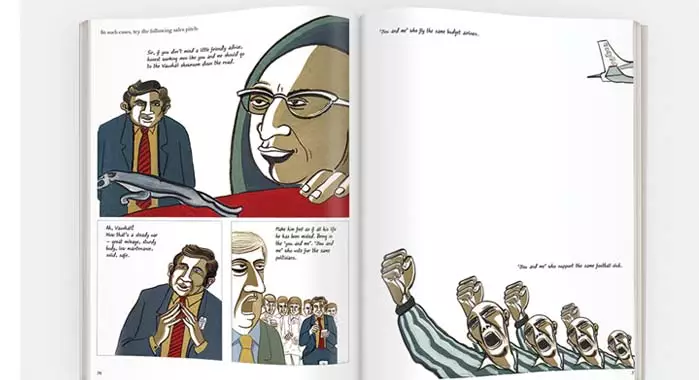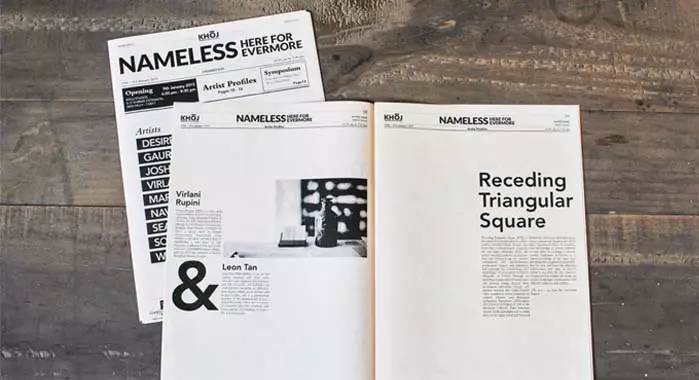Devoting a generous amount of time to research, design thinking, and the process of creation is very important for Studio Eksaat, and the result of that is clearly reflected in their work. Based in Delhi, Studio Eksaat is a communication and interior design studio co-founded by Samira Gupta and Dhritiman Deb Pillai.
They met each other while studying at Srishti School of Art Design & Technology, and worked in different companies for a couple of years before setting up their independent studio. Over the last seven years, Studio Eksaat has created work in various categories, and has also worked extensively with the nonprofit sector.
PrintWeek India speaks to Gupta and Deb Pillai about their beginnings, early challenges, recent work, and their relationship with print. Edited excerpts:
How did you both land up in design?
Samira: I didn’t really have any relationship with the design while growing up. I was pursuing mass communications when I did an internship with Ogilvy. I was working as a copy intern, and for any design work, I had to plead with the art guys all the time. After about six weeks, I was so frustrated that I decided to learn how to do art myself. So I went to Srishti School of Art Design & Technology, and this is where I met Dhritiman.
I worked at Green Goose Design Studio for a couple of years after college. And while I was happy working there, I still wasn’t sure what I wanted to do so I took a sabbatical during which Dhritiman and I decided to start our own studio. We wanted to follow a deeper ethos and a process-oriented approach towards design. We wanted to tailor-make our print. We also wanted to be environmentally conscious in regards to printing.
Dhritiman: I got into design straight after school. I wasn’t academically oriented, and I always enjoyed drawing. I was also very interested in architecture but eventually decided to study product and interior design at Srishti School of Art Design and technology. It was a great experience. From there, I went on to work for an architectural firm for two years, and it was quite an interesting experience. However, I got bothered by the kind of work that was happening as it was very fast paced. I wanted to take it a bit easy and do things that really interested me. And then eventually, as Samira said, we decided to start this studio.
What were some of the early challenges you faced when you started this independent studio?
Samira: We started very small with low expectations. We were never interested in building an empire. It has always been a small studio run by people who actually do the design work. For about two years, it was just two of us, and about 95% of our work in the first few years came through referrals. And that was good for us as it was much easier to understand what the clients expected of us and what aesthetics they were coming from. We had quite a few hits and misses though, especially in terms of doing paperwork and receiving money, but it was all a part of our learning experience.
Dhritiman: Yes, there were challenges in being a small team of creative people. We had to learn how to do accounting and business development, etc. all on our own. Another challenge was that there was a small pool of designers in India when we started out who were not talking to each other. So there was no sense of community.
Samira: Also, when we started out seven years ago, being taken seriously as a woman was a major issue. I had problems dealing with vendors, production people, and clients. There were many below the belt digs about who wears the pants in the relationship - a lot of male chauvinism basically. I could have succumbed to it and let Dhritiman take the lead but instead, we decided to fight this head on. We took a strong stand and told people that we were equals who worked together as a team. It’s still a huge fight for women to be taken seriously, but we are at it.
Could you tell us a bit about your project for Typsy Crow for which you won a few awards last year?
Samira: We had a really good client for this project who gave us an open brief and creative freedom. Typsy Crow – the name of which came from the client – is a Tapas bar in Safdarjung market in Delhi. That area is mainly dominated by college crowd, and we wanted to create this space as an upmarket, comfortable, and enjoyable space for working professionals with disposable incomes.
For this project, we didn’t want to go through the traditional route of creating directly on the system. So we decided to try the linocut printing process where the crow was hand-drawn and cut out from a sheet, and then we printed over it. We wanted texture and an organic feel, so the type was also created on the linocut itself. We went through almost 2-3 weeks of iterations which involved creating a small printmaking space in our studio. We used the colour black in the interiors quite interestingly and had various kinds of crows all over the place in different types of illustrations. We also supported black with electric blue for the interiors as it is a lovely, young color.
We also want to particularly talk about a graphic novel project in your portfolio - The Harappa Files by Sarnath Banerjee. How was the experience of doing the design and collaborating with another artist?
Samira: This is one of the early projects. I had just launched a book with Westland at that time, and the editor got in touch with me about this. Banerjee had been working on this book, and he liked the work I had done. So we worked together closely for a year on this, and he was an absolute dream to work with. This was a perfect example of how collaboration between two creative people should be. There was mutual respect and admiration.
We were looking at all the work he had done and how to put it into the book layout. He gave me the individual artworks, and the detailing in composition happened side by side. The finished product looked good because we created it slowly over a period of time. And this is something we harp on a lot. We always tell our clients that the more time you give us, the better the output will be. We have to fine-tune the design till it can’t be perfected anymore.
You work with a lot of nonprofit clients. Is that something conscious? Also, does that give you more creative freedom vis-à-vis commercial clients?
Samira: It’s more about our belief that design has to make a difference. And I think where it lacks the most is in the nonprofit sector, mainly because there is such a strain on funding. So we started doing pro bono work in this field to show people how design can be so effective and actually make a difference.
We did Anvesha project as a pro bono exercise. We visited villages in Maharashtra, Jharkhand, and Orissa, and met these absolutely fantastic grassroots women leaders and entrepreneurs who were doing great work. We saw their work, did profile shoots for them, and eventually developed a case for why they should fund design.
We also do these small projects for the sector like calendars, annual reports, and booklets. We put emphasis on storytelling as we want to change the way people are consuming information.
So for us, the design is not only about fancy work. It’s also about the ground level work by people whose voices need to be heard. That’s really where the country grows from too.
You spoke about being environmentally conscious earlier. How do you take a call on when to print and when not to?
Samira: Of late, we have started pushing our clients to take a more web-friendly approach. We want to be as environmentally conscious as possible. For example, we do not take up work that includes irregular paper sizes as there is a lot of paper wastage in that. We also tell our clients that unless the print work is something that will actually stay with a reader for some time, it’s not really worth printing. Sometimes, we design a web version and print a smaller batch, so the client can be selective about who receives the print version.
As designers, are there any specific challenges you face when it comes to printing?
Samira: Printing in India is massively difficult. There is very little attention to detailing and printers are not interested in small quantities. There has to be a little bit of give and take when it comes to printing. The cost difference amongst different printers is so much. However, printers are not completely to blame though. The clients want great quality at the lowest possible cost, and that’s an issue.
Dhritiman: The printers have this attitude of ‘chal jayega’. They feel that the finer details don’t matter. The attention to detail only happens when the order is large.
Samira: Yes. And it’s not worth designing something great if the end product doesn’t look great. Also, printers need to be more approachable. There is a lot of hierarchy in the big presses. It needs to be streamlined in order to get much better work.
What are some of your main plans for this year?
Samira: We are looking at larger turnkey projects where we get more time to work on things. We are interested in moving towards projects where design thinking and research is directly linked to the final product.
Dhritiman: However, in terms of categories, we are very open to any kind of work. We want to keep doing new stuff and not get typecast in any way.















 See All
See All